Social Policy in Settlement Work: A Position Paper
VerifiedAdded on 2022/10/01
|6
|1123
|176
AI Summary
This position paper discusses the immigration policy in Canada as compared to the US while discussing the temporary residents in Canada, its categories and eligibility requirements. It is focused on explaining a recent government policy decision or recommendation while critically examining the policy development process.
Contribute Materials
Your contribution can guide someone’s learning journey. Share your
documents today.

Social Policy in Settlement Work
A Position Paper
Student’s Name:
University:
A Position Paper
Student’s Name:
University:
Secure Best Marks with AI Grader
Need help grading? Try our AI Grader for instant feedback on your assignments.
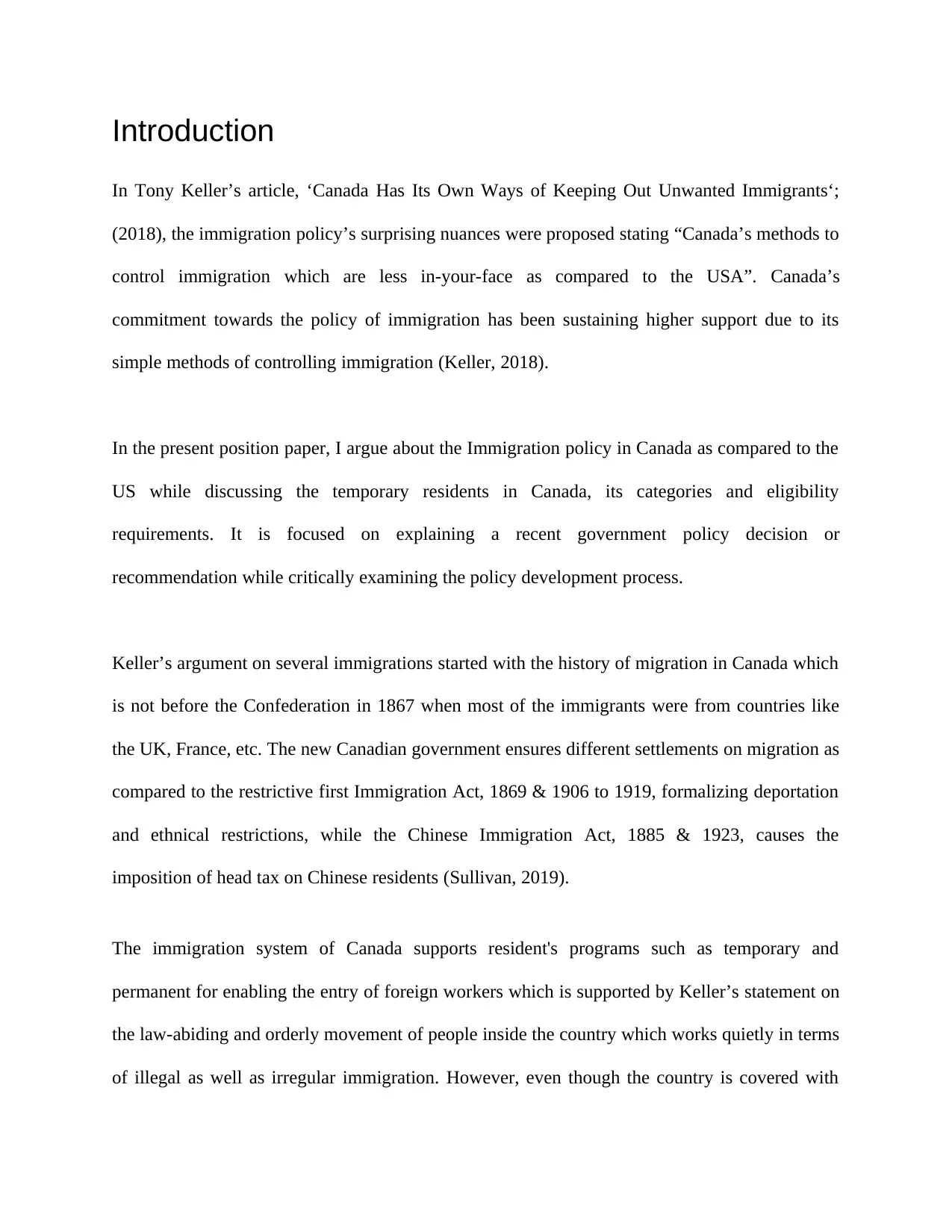
Introduction
In Tony Keller’s article, ‘Canada Has Its Own Ways of Keeping Out Unwanted Immigrants‘;
(2018), the immigration policy’s surprising nuances were proposed stating “Canada’s methods to
control immigration which are less in-your-face as compared to the USA”. Canada’s
commitment towards the policy of immigration has been sustaining higher support due to its
simple methods of controlling immigration (Keller, 2018).
In the present position paper, I argue about the Immigration policy in Canada as compared to the
US while discussing the temporary residents in Canada, its categories and eligibility
requirements. It is focused on explaining a recent government policy decision or
recommendation while critically examining the policy development process.
Keller’s argument on several immigrations started with the history of migration in Canada which
is not before the Confederation in 1867 when most of the immigrants were from countries like
the UK, France, etc. The new Canadian government ensures different settlements on migration as
compared to the restrictive first Immigration Act, 1869 & 1906 to 1919, formalizing deportation
and ethnical restrictions, while the Chinese Immigration Act, 1885 & 1923, causes the
imposition of head tax on Chinese residents (Sullivan, 2019).
The immigration system of Canada supports resident's programs such as temporary and
permanent for enabling the entry of foreign workers which is supported by Keller’s statement on
the law-abiding and orderly movement of people inside the country which works quietly in terms
of illegal as well as irregular immigration. However, even though the country is covered with
In Tony Keller’s article, ‘Canada Has Its Own Ways of Keeping Out Unwanted Immigrants‘;
(2018), the immigration policy’s surprising nuances were proposed stating “Canada’s methods to
control immigration which are less in-your-face as compared to the USA”. Canada’s
commitment towards the policy of immigration has been sustaining higher support due to its
simple methods of controlling immigration (Keller, 2018).
In the present position paper, I argue about the Immigration policy in Canada as compared to the
US while discussing the temporary residents in Canada, its categories and eligibility
requirements. It is focused on explaining a recent government policy decision or
recommendation while critically examining the policy development process.
Keller’s argument on several immigrations started with the history of migration in Canada which
is not before the Confederation in 1867 when most of the immigrants were from countries like
the UK, France, etc. The new Canadian government ensures different settlements on migration as
compared to the restrictive first Immigration Act, 1869 & 1906 to 1919, formalizing deportation
and ethnical restrictions, while the Chinese Immigration Act, 1885 & 1923, causes the
imposition of head tax on Chinese residents (Sullivan, 2019).
The immigration system of Canada supports resident's programs such as temporary and
permanent for enabling the entry of foreign workers which is supported by Keller’s statement on
the law-abiding and orderly movement of people inside the country which works quietly in terms
of illegal as well as irregular immigration. However, even though the country is covered with
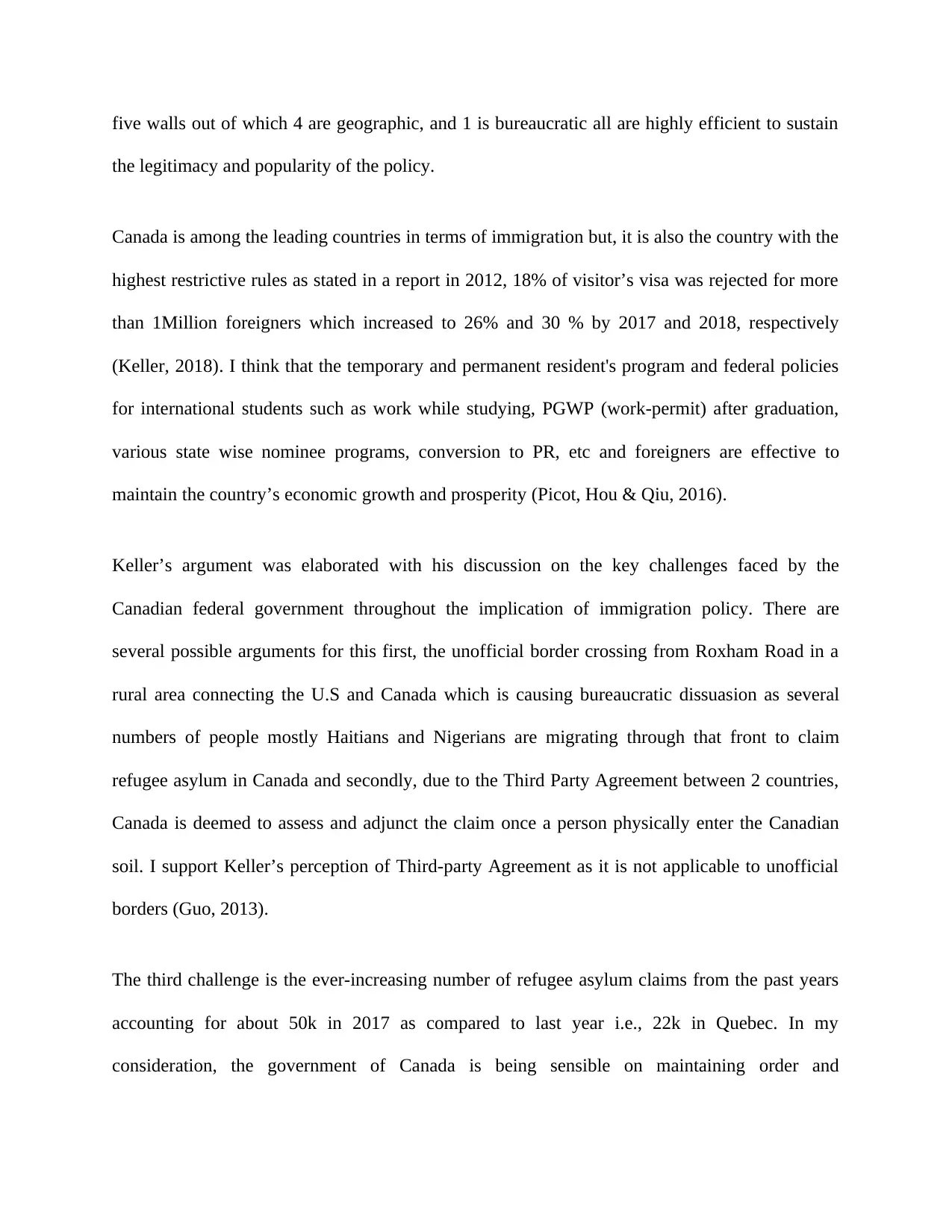
five walls out of which 4 are geographic, and 1 is bureaucratic all are highly efficient to sustain
the legitimacy and popularity of the policy.
Canada is among the leading countries in terms of immigration but, it is also the country with the
highest restrictive rules as stated in a report in 2012, 18% of visitor’s visa was rejected for more
than 1Million foreigners which increased to 26% and 30 % by 2017 and 2018, respectively
(Keller, 2018). I think that the temporary and permanent resident's program and federal policies
for international students such as work while studying, PGWP (work-permit) after graduation,
various state wise nominee programs, conversion to PR, etc and foreigners are effective to
maintain the country’s economic growth and prosperity (Picot, Hou & Qiu, 2016).
Keller’s argument was elaborated with his discussion on the key challenges faced by the
Canadian federal government throughout the implication of immigration policy. There are
several possible arguments for this first, the unofficial border crossing from Roxham Road in a
rural area connecting the U.S and Canada which is causing bureaucratic dissuasion as several
numbers of people mostly Haitians and Nigerians are migrating through that front to claim
refugee asylum in Canada and secondly, due to the Third Party Agreement between 2 countries,
Canada is deemed to assess and adjunct the claim once a person physically enter the Canadian
soil. I support Keller’s perception of Third-party Agreement as it is not applicable to unofficial
borders (Guo, 2013).
The third challenge is the ever-increasing number of refugee asylum claims from the past years
accounting for about 50k in 2017 as compared to last year i.e., 22k in Quebec. In my
consideration, the government of Canada is being sensible on maintaining order and
the legitimacy and popularity of the policy.
Canada is among the leading countries in terms of immigration but, it is also the country with the
highest restrictive rules as stated in a report in 2012, 18% of visitor’s visa was rejected for more
than 1Million foreigners which increased to 26% and 30 % by 2017 and 2018, respectively
(Keller, 2018). I think that the temporary and permanent resident's program and federal policies
for international students such as work while studying, PGWP (work-permit) after graduation,
various state wise nominee programs, conversion to PR, etc and foreigners are effective to
maintain the country’s economic growth and prosperity (Picot, Hou & Qiu, 2016).
Keller’s argument was elaborated with his discussion on the key challenges faced by the
Canadian federal government throughout the implication of immigration policy. There are
several possible arguments for this first, the unofficial border crossing from Roxham Road in a
rural area connecting the U.S and Canada which is causing bureaucratic dissuasion as several
numbers of people mostly Haitians and Nigerians are migrating through that front to claim
refugee asylum in Canada and secondly, due to the Third Party Agreement between 2 countries,
Canada is deemed to assess and adjunct the claim once a person physically enter the Canadian
soil. I support Keller’s perception of Third-party Agreement as it is not applicable to unofficial
borders (Guo, 2013).
The third challenge is the ever-increasing number of refugee asylum claims from the past years
accounting for about 50k in 2017 as compared to last year i.e., 22k in Quebec. In my
consideration, the government of Canada is being sensible on maintaining order and
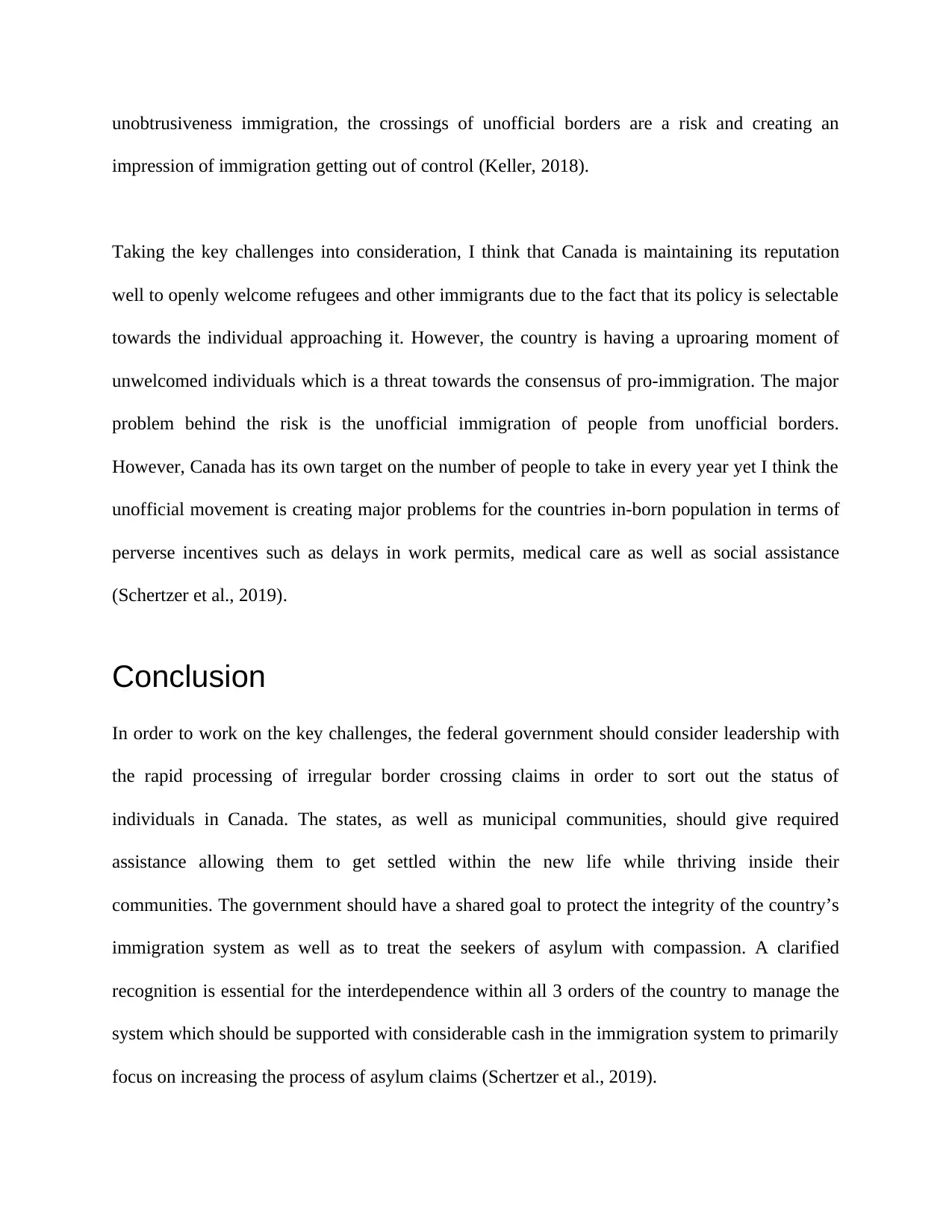
unobtrusiveness immigration, the crossings of unofficial borders are a risk and creating an
impression of immigration getting out of control (Keller, 2018).
Taking the key challenges into consideration, I think that Canada is maintaining its reputation
well to openly welcome refugees and other immigrants due to the fact that its policy is selectable
towards the individual approaching it. However, the country is having a uproaring moment of
unwelcomed individuals which is a threat towards the consensus of pro-immigration. The major
problem behind the risk is the unofficial immigration of people from unofficial borders.
However, Canada has its own target on the number of people to take in every year yet I think the
unofficial movement is creating major problems for the countries in-born population in terms of
perverse incentives such as delays in work permits, medical care as well as social assistance
(Schertzer et al., 2019).
Conclusion
In order to work on the key challenges, the federal government should consider leadership with
the rapid processing of irregular border crossing claims in order to sort out the status of
individuals in Canada. The states, as well as municipal communities, should give required
assistance allowing them to get settled within the new life while thriving inside their
communities. The government should have a shared goal to protect the integrity of the country’s
immigration system as well as to treat the seekers of asylum with compassion. A clarified
recognition is essential for the interdependence within all 3 orders of the country to manage the
system which should be supported with considerable cash in the immigration system to primarily
focus on increasing the process of asylum claims (Schertzer et al., 2019).
impression of immigration getting out of control (Keller, 2018).
Taking the key challenges into consideration, I think that Canada is maintaining its reputation
well to openly welcome refugees and other immigrants due to the fact that its policy is selectable
towards the individual approaching it. However, the country is having a uproaring moment of
unwelcomed individuals which is a threat towards the consensus of pro-immigration. The major
problem behind the risk is the unofficial immigration of people from unofficial borders.
However, Canada has its own target on the number of people to take in every year yet I think the
unofficial movement is creating major problems for the countries in-born population in terms of
perverse incentives such as delays in work permits, medical care as well as social assistance
(Schertzer et al., 2019).
Conclusion
In order to work on the key challenges, the federal government should consider leadership with
the rapid processing of irregular border crossing claims in order to sort out the status of
individuals in Canada. The states, as well as municipal communities, should give required
assistance allowing them to get settled within the new life while thriving inside their
communities. The government should have a shared goal to protect the integrity of the country’s
immigration system as well as to treat the seekers of asylum with compassion. A clarified
recognition is essential for the interdependence within all 3 orders of the country to manage the
system which should be supported with considerable cash in the immigration system to primarily
focus on increasing the process of asylum claims (Schertzer et al., 2019).
Secure Best Marks with AI Grader
Need help grading? Try our AI Grader for instant feedback on your assignments.
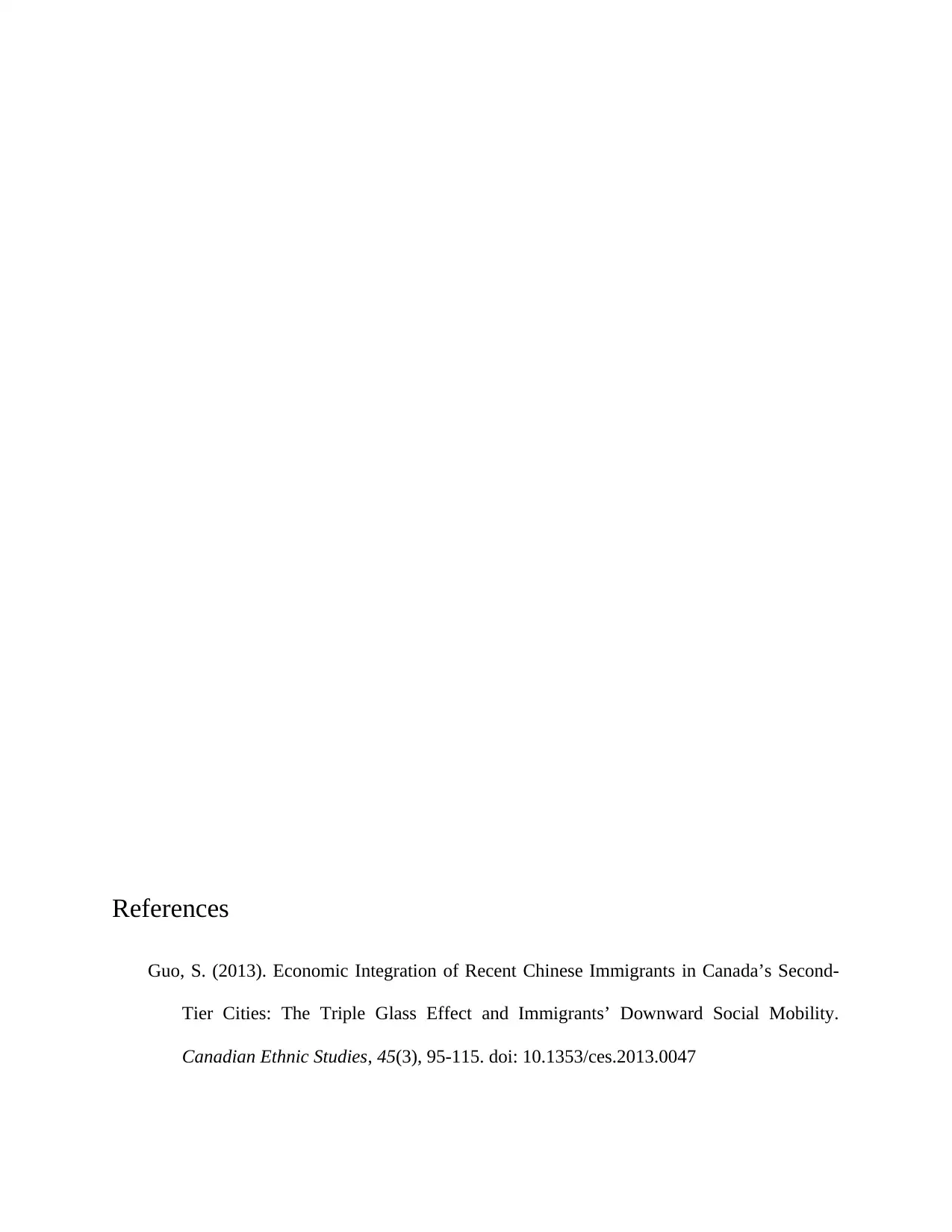
References
Guo, S. (2013). Economic Integration of Recent Chinese Immigrants in Canada’s Second-
Tier Cities: The Triple Glass Effect and Immigrants’ Downward Social Mobility.
Canadian Ethnic Studies, 45(3), 95-115. doi: 10.1353/ces.2013.0047
Guo, S. (2013). Economic Integration of Recent Chinese Immigrants in Canada’s Second-
Tier Cities: The Triple Glass Effect and Immigrants’ Downward Social Mobility.
Canadian Ethnic Studies, 45(3), 95-115. doi: 10.1353/ces.2013.0047
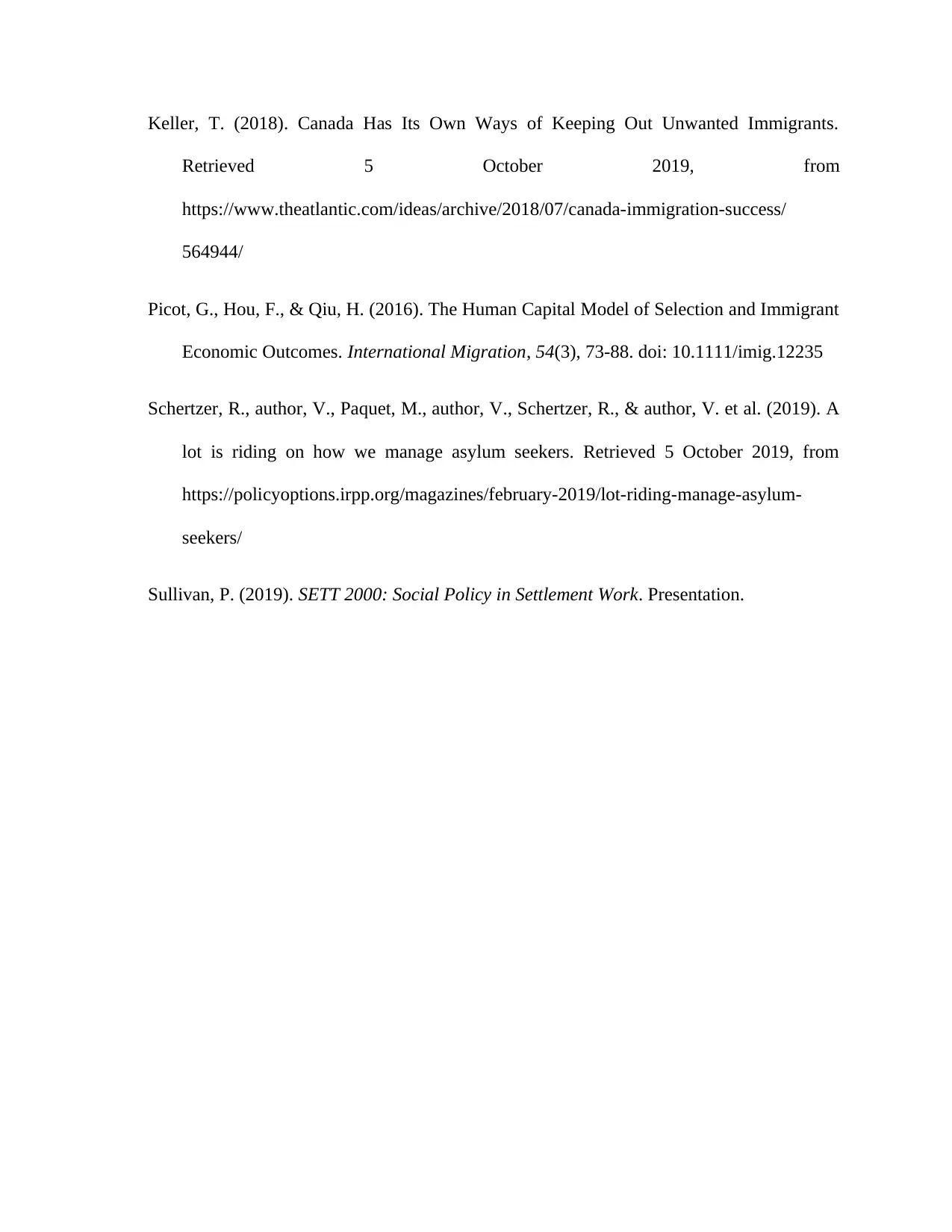
Keller, T. (2018). Canada Has Its Own Ways of Keeping Out Unwanted Immigrants.
Retrieved 5 October 2019, from
https://www.theatlantic.com/ideas/archive/2018/07/canada-immigration-success/
564944/
Picot, G., Hou, F., & Qiu, H. (2016). The Human Capital Model of Selection and Immigrant
Economic Outcomes. International Migration, 54(3), 73-88. doi: 10.1111/imig.12235
Schertzer, R., author, V., Paquet, M., author, V., Schertzer, R., & author, V. et al. (2019). A
lot is riding on how we manage asylum seekers. Retrieved 5 October 2019, from
https://policyoptions.irpp.org/magazines/february-2019/lot-riding-manage-asylum-
seekers/
Sullivan, P. (2019). SETT 2000: Social Policy in Settlement Work. Presentation.
Retrieved 5 October 2019, from
https://www.theatlantic.com/ideas/archive/2018/07/canada-immigration-success/
564944/
Picot, G., Hou, F., & Qiu, H. (2016). The Human Capital Model of Selection and Immigrant
Economic Outcomes. International Migration, 54(3), 73-88. doi: 10.1111/imig.12235
Schertzer, R., author, V., Paquet, M., author, V., Schertzer, R., & author, V. et al. (2019). A
lot is riding on how we manage asylum seekers. Retrieved 5 October 2019, from
https://policyoptions.irpp.org/magazines/february-2019/lot-riding-manage-asylum-
seekers/
Sullivan, P. (2019). SETT 2000: Social Policy in Settlement Work. Presentation.
1 out of 6
Related Documents
Your All-in-One AI-Powered Toolkit for Academic Success.
+13062052269
info@desklib.com
Available 24*7 on WhatsApp / Email
![[object Object]](/_next/static/media/star-bottom.7253800d.svg)
Unlock your academic potential
© 2024 | Zucol Services PVT LTD | All rights reserved.





